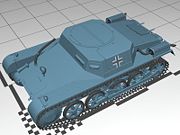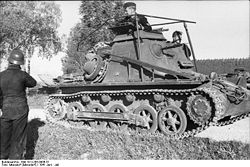
Panzer I variants
Encyclopedia
Panzerkampfwagen I Ausf A ohne Aufbau
Actually the first Panzer I vehicles to be built, 15 were completed by the various firms included in the program (Daimler-BenzDaimler-Benz
Daimler-Benz AG was a German manufacturer of automobiles, motor vehicles, and internal combustion engines; founded in 1926. An Agreement of Mutual Interest - which was valid until year 2000 - was signed on 1 May 1924 between Karl Benz's Benz & Cie., and Daimler Motoren Gesellschaft, which had...
, Henschel, Krupp
Krupp
The Krupp family , a prominent 400-year-old German dynasty from Essen, have become famous for their steel production and for their manufacture of ammunition and armaments. The family business, known as Friedrich Krupp AG Hoesch-Krupp, was the largest company in Europe at the beginning of the 20th...
, MAN, and Rheinmetall
Rheinmetall
Rheinmetall AG is a German automotive and defence company with factories in Düsseldorf, Kassel and Unterlüß. The company has a long tradition of making guns and artillery pieces...
) to develop their industrial capacity and provide initial training vehicles to the Wehrmacht
Wehrmacht
The Wehrmacht – from , to defend and , the might/power) were the unified armed forces of Nazi Germany from 1935 to 1945. It consisted of the Heer , the Kriegsmarine and the Luftwaffe .-Origin and use of the term:...
. The Ausf A ohne Aufbau was merely a Panzer I hull without superstructure or turret. The interior was completely open, and was crewed by a driving student and instructor with room for three student observers behind them. The suspension and hull were identical to the Ausf A, but total weight was reduced to 3.5 tons and height to 1.15 m. Performance was similar.
Munitionsschlepper auf Panzerkampfwagen I Ausf A

Brückenleger auf Panzerkampfwagen I Ausf A
An attempt to mount bridging equipment on the Ausf A chassis proved impractical due to the weak suspension of the vehicle, although this was later tried with greater success on the Panzer IIPanzer II
The Panzer II was the common name for a family of German tanks used in World War II. The official German designation was Panzerkampfwagen II...
chassis.
Flammenwerfer auf Panzerkampfwagen I Ausf A
A simple field modification, the Flammenwerfer consisted simply of a portable flamethrower being mounted in place of one of the machine guns with enough fuel for about 10 seconds of firing at a range of up to 25 m. The idea came from an experiment during the Spanish Civil WarSpanish Civil War
The Spanish Civil WarAlso known as The Crusade among Nationalists, the Fourth Carlist War among Carlists, and The Rebellion or Uprising among Republicans. was a major conflict fought in Spain from 17 July 1936 to 1 April 1939...
intended to give the Panzer I more firepower against close targets. The conversion was not permanent, and was only reported to be used in the Battle of Tobruk by the German 5th Light Division.
Kleiner Panzerbefehlswagen (klPzBefWg)

Given the designation SdKfz 265, the klPzBefWg was designed from the Ausf A to provide a command vehicle for panzer units. This required lengthening the chassis (by adding a fifth road wheel) and upgrading the engine. Ultimately, this chassis would be the basis for the improved Ausf B version. The klPzBefWg also differed in replacing the turret with a built up superstructure, affording more interior room for command equipment and a FuG6 radio in addition to the FuG2. A single MG13 or MG34 in a ball mount on the front of the superstructure was provided, although often removed. Slightly heavier (5.9 tons) and taller (1.99 m) than the Ausf B, the klPzBefWg served with all panzer units into the early war years. It did receive an additional 15 mm of armor later, but eventually was moved to auxiliary duties by 1942. 184 were built by Daimler-Benz at the same time as Ausf B production, as well as six examples built from Ausf A tanks.
Panzerkampfwagen I Ausf B ohne Aufbau
The Ausf B ohne Aufbau used the same chassis as the Ausf B, but deleted the superstructure and turret. Designed to provide panzer units with a tracked recovery and repair vehicle, 164 were produced alongside the standard Ausf B vehicles. However, the introduction of larger tanks left it unable to do recovery work and by 1940 it was being transferred to training duties. Versus the Ausf B it was much lighter (4.0 tons) and shorter (1.35 m). Like the Ausf A ohne Aufbau, the compartment was open topped, but the hull was armored.4.7 cm PaK (t) (Sf) auf Panzerkampfwagen I Ausf B
Commonly known as the Panzerjäger IPanzerjäger I
The Panzerjäger I was the first of the German tank destroyers to see service in the Second World War. It mounted a Czech Skoda cm PaK anti-tank gun on a converted Panzer I Ausf. B chassis...
, this version marked Germany's first attempt at an armored tank destroyer. The turret was removed, and a 4.7 cm PaK (t) antitank gun (captured from Czechoslovakia) with a tall wrap-around gun shield installed instead. Although made from 14.5 mm thick armor plate the shield offered no protection to the rear or above. The gun was capable of 35° of traverse and elevation from -8° to +12°. 86 rounds were carried for the main gun. While performance was similar to the Ausf B, it was heavier at 6.4 tons and taller, 2.25 m, than the B.
15 cm sIG 33 (Sf) auf Panzerkampfwagen I Ausf B

Bison
Members of the genus Bison are large, even-toed ungulates within the subfamily Bovinae. Two extant and four extinct species are recognized...
. The larger Ausf B chassis made possible the mounting of heavier guns with removal of the turret. The largest was the 150 mm heavy infantry gun, the sIG 33. This mammoth piece was relatively short and fit just barely in a tall superstructure not only built up to the vehicle's 2.8 m height but also out over the tracks to their full 2.06 m width. The superstructure armor was light at only 13 mm and only protected the front and sides. The heavy resulting weight of 8.5 tons overstressed the chassis and ultimately, the vehicle was not a great success. 38 were converted from Ausf B tanks in February 1940 and they served with six heavy SP infantry gun companies with survivors in service into 1943. The sIG mounting was capable of 25 ° of traverse and 75 ° of elevation, and could be depressed to -4 °. It used a Rblf36 sight, and ammunition was carried separately, there being no room for onboard shell storage. The sIG would be mounted more successfully on larger chassis as the war progressed.
Flammenwerfer auf Panzerkampfwagen I Ausf B
An experiment at a field modification similar to that done to the Ausf A later in North Africa, this conversion was made during the Spanish Civil WarSpanish Civil War
The Spanish Civil WarAlso known as The Crusade among Nationalists, the Fourth Carlist War among Carlists, and The Rebellion or Uprising among Republicans. was a major conflict fought in Spain from 17 July 1936 to 1 April 1939...
, although there is no record of later use during World War II
World War II
World War II, or the Second World War , was a global conflict lasting from 1939 to 1945, involving most of the world's nations—including all of the great powers—eventually forming two opposing military alliances: the Allies and the Axis...
.
Ladungsleger auf Panzerkampfwagen I Ausf B
A field modification kit, the Ladungsleger, or explosives layer, was mounted on the rear deck of an Ausf B tank and used to lay explosives to defeat field fortifications. A number of vehicles were given these kits, with authorized use on the armored engineers company of each Pioneer Battalion.Flakpanzer I
A rare modification that attempted to make the Panzer I into a self-propelled anti-aircraft gun was the Flakpanzer IFlakpanzer I
The Flakpanzer I was a rare self propelled anti-aircraft gun conversion of the Panzer I in use by Nazi Germany during World War II. Its designation was Sd.Kfz.101 .-Development History:...
. It was not produced widely due to extremely high developmental costs.

